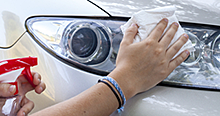
Those bright bulbs in your headlights don’t help much if the plastic guarding them is cloudy and stained. Hazy lenses can dramatically reduce visibility, making night driving potentially hazardous.
“It doesn’t matter how high-performance the bulbs are if there is yellowing on the outside of the housing,” said Michael Pennington, the global director of training and consumer relations for Meguiar’s. “Dimmer lights make it harder for cars to see you, and it’s harder for you to see the road ahead at night.”
Headlights get that yellowish, cloudy look from ultraviolet light slowly breaking down the protective coating. This also occurs because they are subjected to temperature changes, humidity and the other assorted elements of the open road.
Professional auto technicians usually can remove even the most stubborn oxidation stains.
Some products are a liquid-based polishing compound, while others combine abrasive pads to be used in a drill with a finer polishing liquid for finishing work. Technicians choose the process based on the level of oxidation, Pennington said.
Sanding the headlights manually is ideal for light to moderate discoloration, while more significant build-up will require a more labor-intensive process, he said.
“Plan for a more involved process for the more oxidation you have,” Pennington said.
There’s no restoration formula for a cracked headlight, Pennington said. A damaged casing means the airtight seal is broken, so condensation accumulates inside the housing.
Pennington offers the following tips routine for headlight restoration products:
- Check to see if dirt and road grime need to be removed from your headlights whenever you clean your windshield.
- If you are going to replace headlight bulbs, swap out both at the same time.
- Headlights begin to discolor as they age and many repair shops have the equipment to restore headlights on site.
Copyright © 2024 by Sensible Driver. All rights reserved.